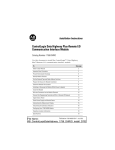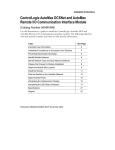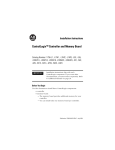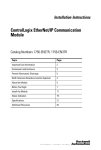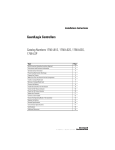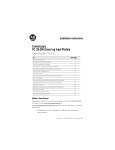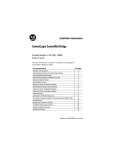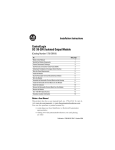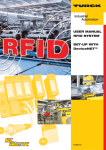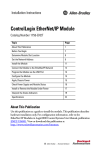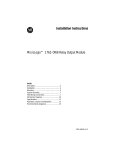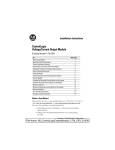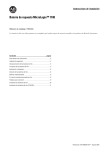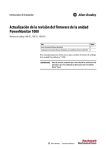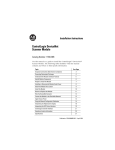Download 1756-IN003A-EN-P, ControlLogix Data Highway Plus
Transcript
Installation Instructions ControlLogix Data Highway Plus-Remote I/O Communication Interface Module (Catalog Number 1756-DHRIO) Use this document as a guide to install the ControlLogixTM Data Highway PlusTM-Remote I/O communication interface module. The following table lists what this manual contains and where to find specific information. Topic See page Important User Information 2 Understand Compliance to European Union Directive 4 Preventing Electrostatic Discharge 5 Identify Module Features 6 Set the Network Type and Node Address Switches 7 Prepare the Chassis for Module Installation 8 Determine Module Slot Location 9 Installing or Removing the Module While Power Is Applied 10 Install the Module 11 Wire the Connectors for the Module Channels 13 Connect the Programming Terminal and DH+ or Remote I/O Network 14 Apply Chassis Power 15 Check Power Supply and Module Status 15 Interpreting the Alphanumeric Display 17 Interpreting the LED Status Indicators 18 Where to Find Information on Configuring Your 1756-DHRIO Module 19 Hazardous Location information 20 Specifications 22 Publication 1756-IN003A-EN-P - May 2001 2 Important User Information Because of the variety of uses for the products described in this publication, those responsible for the application and use of this control equipment must satisfy themselves that all necessary steps have been taken to assure that each application and use meets all performance and safety requirements, including any applicable laws, regulations, codes and standards. The illustrations, charts, sample programs and layout examples shown in this guide are intended solely for purposes of example. Since there are many variables and requirements associated with any particular installation, Allen-Bradley does not assume responsibility or liability (to include intellectual property liability) for actual use based upon the examples shown in this publication. Allen-Bradley publication SGI-1.1, Safety Guidelines for the Application, Installation and Maintenance of Solid-State Control (available from your local Allen-Bradley office), describes some important differences between solid-state equipment and electromechanical devices that should be taken into consideration when applying products such as those described in this publication. Reproduction of the contents of this copyrighted publication, in whole or part, without written permission of Rockwell Automation, is prohibited. Publication 1756-IN003A-EN-P - May 2001 3 Throughout this manual we use the following notes to make you aware of safety considerations: WARNING ! ATTENTION ! Identifies information about practices or circumstances that have the potential to create an explosion hazard. Identifies information about other practices or circumstances that can lead to personal injury or death, property damage or economic loss. Warning and Attention statements help you to: • identify a hazard • avoid a hazard • recognize the consequences We use the following note to call attention to critical information: IMPORTANT Identifies information that is critical for successful application and understanding of the product. Change bars are used to indicate information that has changed or been added since the previous version of these instructions. Publication 1756-IN003A-EN-P - May 2001 4 Understand Compliance to European Union Directive If this product bears the CE marking, it is approved for installation within the European Union and EEA regions. It has been designed and tested to meet the following directives. EMC Directive This product is tested to meet Council Directive 89/336/EEC Electromagnetic Compatibility (EMC) and the following standards, in whole or in part, documented in a technical construction file: • EN 50081-2 EMC - Generic Emission Standard, Part 2 Industrial Environment • EN 50082-2 EMC - Generic Immunity Standard, Part 2 Industrial Environment This product is intended for use in an industrial environment. Low Voltage Directive This product is tested to meet Council Directive 73/23/EEC Low Voltage, by applying the safety requirements of EN 61131-2 Programmable Controllers, Part 2 - Equipment Requirements and Tests. For specific information required by EN 61131-2, see the appropriate sections in this publication, as well as the following Allen-Bradley publications: • Industrial Automation Wiring and Grounding Guidelines, publication 1770-4.1 • Automation Systems Catalog, publication B113 Open style devices must be provided with environmental and safety protection by proper mounting in enclosures designed for specific application conditions. See NEMA Standards publication 250 and IEC publication 529, as applicable, for explanations of the degrees of protection provided by different types of enclosure. Publication 1756-IN003A-EN-P - May 2001 5 Enclosure and Environmental Requirements Specific To This Product This product must be mounted within a suitable system enclosure to prevent personal injury resulting from accessibility to live parts. The interior of this enclosure must be accessible only by the use of a tool. This industrial control equipment is intended to operate in a Pollution Degree 2 environment, in overvoltage category II applications, (as defined in IEC publication 664A) at altitudes up to 2000 meters without derating. Preventing Electrostatic Discharge The 1756-DHRIO module is sensitive to electrostatic discharge. ATTENTION ! Electrostatic discharge can damage integrated circuits or semiconductors if you touch backplane connector pins. Follow these guidelines when you handle the module: • Touch a grounded object to discharge static potential • Wear an approved wrist-strap grounding device • Do not touch the backplane connector or connector pins • Do not touch circuit components inside the module • If available, use a static-safe work station • When not in use, keep the module in its static-shield bag For additional information refer to publication 1770-4.1, Industrial Automation Wiring and Grounding Guidelines. Publication 1756-IN003A-EN-P - May 2001 6 Identify Module Features Refer to the following figure to identify the hardware components of the 1756-DHRIO module. Network Type Switches (behind cover) Backplane connector Alphanumeric Status Indicator DH+/RIO 123 0 4 7 65 Switch 1 Switch 6 Channel A Network Type Channel B Network Type Specify Network Type DH+ Channel RIO Scanner A Illegal DH+ Channel RIO Scanner B Illegal Set Switch 0 1 2-7 0 1 2-7 Channel B Address Shown in 24 Position Channel A Address Shown in 10 Position Switch 4 Switch 5 (10s) (1s) Switch 2 Switch 3 (10s) (1s) 123 0 4 7 65 765 0 123 4 123 0 4 7 65 1 123 0 4 7 65 Channel and Module Status Indicators Wiring Label CH A CH B OK 8-pin Mini DIN Programming Terminal Connector A Channel A Connector 1 B Channel B Connector 1 123 0 4 7 65 1 2 DH+ CLR SHLD BLU RIO BLU SHD CLR 1756-DHRIO Side View Node Address Switches (behind cover) Publication 1756-IN003A-EN-P - May 2001 Front View Door 7 Set the Network Type and Node Address Switches Before you install the module, you must set the network type switches for each channel. If the network type is Data Highway Plus (DH+), you must also set the node address switches for that channel to a unique address within the range of 00-77. Do not set node address switches if you are using remote I/O. 1 2 3 4 7 6 5 1 2 3 0 This example shows channel A set for DH+ and channel B set for RIO. 4 7 6 5 1 2 3 1 2 3 4 0 4 7 6 5 7 6 5 Switch 6 Channel A Network Type Channel B Network Type To Specify Network Type RIO Scanner 0 1 Illegal 2-7 DH+ Channel B RIO Scanner 0 1 Illegal 2-7 Refer to the label for switch settings. Channel B Address Shown in 24 Position Channel A Address Shown in 10 Position Switch 4 (10s) Switch 3 (1s) Switch 2 (10s) 7 6 5 7 6 5 1 2 3 4 7 6 5 0 Switch 5 (1s) 7 6 5 4 1 2 3 1 2 3 4 0 7 6 5 0 7 6 5 4 0 1 2 3 1 2 3 4 7 6 5 0 4 1 2 3 7 6 5 0 4 1 2 3 Node Address Switches (behind cover) Set Switches DH+ Channel A 0 0 Switch 1 4 0 1 2 3 Network Type Switches (behind cover) 0 IMPORTANT This example shows channel A node address at 10 and channel B node address at 24. Publication 1756-IN003A-EN-P - May 2001 8 Prepare the Chassis for Module Installation Before you install the DHRIO module, you must install and connect a ControlLogix chassis and power supply. Power Supply Chassis For information on installing these products, refer to the publications listed in the following table. Chassis Type Chassis Installation Power Supply Power Supply Installation Series B: 1756-A4, -A7, -A10, -A13 Pub. No. 1756-IN080 1756-PA72/B Pub. No. 1756-5.67 1756-PB72/B 1756-PA75/A 1756-PB75/A Publication 1756-IN003A-EN-P - May 2001 Pub. No. 1756-5.78 9 Determine Module Slot Location The figure below shows chassis slot numbering in a 4-slot chassis. Slot 0 is the first slot and is always the leftmost slot in the rack (the first slot to the right of the power supply). You can use any size ControlLogix chassis and install the module in any slot. You can also install multiple 1756-DHRIO modules in the same chassis. You can install as many modules as your power supply can accommodate (i.e., number for which the power supply is rated). Slot 2 Slot 0 Slot 1 Slot 3 Power Supply Chassis Publication 1756-IN003A-EN-P - May 2001 10 Installing or Removing the Module While Power Is Applied You can install or remove the module while chassis power is applied if you observe the following precautions. WARNING ! When you insert or remove a module while backplane power is on, an electrical arc may occur. An electrical arc can cause personal injury or property damage by: • sending an erroneous signal to your system’s actuators causing unintended machine motion or loss of process control. • causing an explosion in a hazardous environment. Repeated electrical arcing causes excessive wear to contacts on both the module and its mating connector. Worn contacts may create electrical resistance that can affect module operation. Publication 1756-IN003A-EN-P - May 2001 11 Install the Module Do not force the module into the backplane connector. If you cannot seat the module with firm pressure, check the alignment. Forcing the module into the chassis can damage the backplane connector or the module. ATTENTION ! 1 Align the circuit board with top and bottom guides in the chassis. POWER Circuit board 2 Slide the module into the chassis. Make sure the module backplane connector properly connects to the chassis backplane. The module is properly installed when it is flush with the power supply or other installed modules. 3 Publication 1756-IN003A-EN-P - May 2001 12 Removing or Replacing the Module (When Applicable) 1 Push on upper and lower module tabs to disengage them. POWER POWER 2 Slide module out of chassis. If you are replacing an existing module with an identical one, and you want to resume identical system operation, you must install the new module in the same slot. Publication 1756-IN003A-EN-P - May 2001 13 Wire the Connectors for the Module Channels DH+/RIO 8-pin mini DIN programming terminal connection parallel to channel A when channel A is configured for DH+ communication. Wiring Label CH A CH B OK 6 3 1 7 4 2 8 5 A Pin Assignments for Channel A and B Connectors DH+ Pin no: Desc: Pin no: Desc: 1 Clear 1 Blue Shield 2 2 Remote I/O Blue Shield 2 Clear B 1 Channel A and B Connectors 1 2 DH+ CLR SHLDBLUE RIO BLUE SHLD CLR Publication 1756-IN003A-EN-P - May 2001 14 Connect the Programming Terminal and DH+ or Remote I/O Network POWER POWER 1 Connect the programming terminal to the 8-pin mini DIN connector. IMPORTANT 2 Connect the DH+ or Remote I/O network to the channel A or B connector as appropriate. For hazardous locations, use a 1784-CP13 cable (or equivalent connector) for the programming terminal connection. Publication 1756-IN003A-EN-P - May 2001 15 Apply Chassis Power ON ON POWER OFF POWER OFF Check Power Supply and Module Status Alphanumeric status indicator illuminates and cycles through a sequence of messages (described in the table on the following page). H+/RIO CHA CHB OK Module OK status indicator is solid red, then flashing green. Power Supply indicator is green. Publication 1756-IN003A-EN-P - May 2001 16 Upon powerup the module’s alphanumeric display cycles through the following sequences. Alphanumeric Status Display Powerup Messages Data Highway Plus Sequence of display: A DH A#xx xxxx Remote I/O Sequence of display: B IO SCAN xxxx Where: A is the channel (A or B) and DH indicates network type is DH+ xx is the channel’s node address xxxx is the channel’s status message Where: B is the channel (A or B) and IO indicates the network type is Remote I/O SCAN indicates scanner xxxx is the channel’s status message Troubleshooting the Power Supply If the alphanumeric indicator on the 1756-DHRIO module does not cycle through these messages on powerup, refer to the following table and to the Troubleshooting section that follows. Power Supply Indicator If the POWER indicator is: Power Supply Status is Recommended Action: Off Not operating. Turn power switch ON. Check power wiring connections. Check fuse. On Operating. None, normal operation. Publication 1756-IN003A-EN-P - May 2001 17 Interpreting the Alphanumeric Display Your 1756-DHRIO module displays alphanumeric codes that provide diagnostic information about your module. The alphanumeric display flashes the codes at approximately 1 second intervals. The following table summarizes the codes. Alphanumeric Display Status Messages Code Description Recommended Action Data Highway Plus OFF LINE Data Highway Plus link is Correct the configuration. in STOP state. Refer to the configuration chapter of the Data Highway Plus-Remote I/O Communication Interface User Manual, publication 1756-6.5.14. DUPL NODE Data Highway Plus Duplicate node address. Choose another node address and reset switches. ONLY NODE Only node on Data Highway Plus link. Check the cables. CNFG FALT Incorrect Data Highway Plus routing table configuration. Incorrect Data Highway object configuration. Correct the configuration. Refer to the configuration chapter of the Data Highway Plus-Remote I/O Communication Interface User Manual, publication 1756-6.5.14. Verify the module is inserted into the correct slot. OK Normal operation for that channel. None. MUTE LINK No adapters found on remote I/O. Add an adapter to the remote I/O network. RACK OVER Rack overlap on remote I/O. Reconfigure remote I/O racks. DUPL SCAN Duplicate scanner on remote I/O. Check remote I/O adapter settings. MAX_ DEV_ Maximum devices Remove devices to meet limitations on exceeded on remote I/O. remote I/O network. CHAT LINK Babble detected on remote I/O. Remote I/O Check remote I/O device and network connections. Publication 1756-IN003A-EN-P - May 2001 18 Alphanumeric Display Status Messages Code Description Recommended Action OFF_ LINE Not trying to communicate. None. Normal state if controller is not controlling remote I/O. OK Normal operation for that channel. None. Remote I/O Interpreting the LED Status Indicators The three LED status indicators on the module provide information about your module and the status of each channel. The following tables outline the indicator condition and the corresponding status, and explain what each condition means. Module Status - OK Indicator Condition Module Status Recommended Action Off Not operating. Apply chassis power. Verify module is completely inserted into chassis and backplane. Green flashing Operating but not routing messages and no controller transferring I/O. None, if no messages are actively being routed through the module and no controller transferring I/O. To route messages or transfer I/O, use module default configuration or configure module. Red, then Off Performing self-test. None, normal operation. Green Operating and routing messages. Verify module configuration. Red In major fault Reboot module. If red reoccurs, then replace module. Red flashing In major fault or configuration fault. Check alphanumeric indicator and take action described in alphanumeric display status message table beginning on page 17. Publication 1756-IN003A-EN-P - May 2001 19 Channel Status - Channel A and Channel B Indicators If the channel A or B indicator is: in this channel then the channel mode: status is: take this action: Off All Not on line. Place channel on line. Green RIO scanner Active RIO link. All None, normal operation. adapter modules are present and not faulted. DH+ Operating. None, normal operation. Green flashing RIO scanner One or more nodes faulted or failed. Check power at other racks. DH+ No other node on the network. Check cables. Red All Hardware fault. Reboot module. If red reoccurs, then Red flashing RIO scanner Faulted adapters detected. DH+ Duplicate node detected. replace module. Check cables. Check power at other racks. Check node address. Where to Find Information on Configuring Your 1756-DHRIO Module Now that you have installed your Data Highway Plus-Remote I/O module, you must configure it. For this information, refer to the configuration chapter of your Data Highway Plus-Remote I/O Communication Interface Module User Manual, publication 1756-6.5.14. Publication 1756-IN003A-EN-P - May 2001 20 Hazardous Location information The following information applies when operating this equipment in hazardous locations: Products marked “CL I, DIV 2, GP A, B, C, D” are suitable for use in Class I Division 2 Groups A, B, C, D, Hazardous Locations and nonhazardous locations only. Each product is supplied with markings on the rating nameplate indicating the hazardous location temperature code. When combining products within a system, the most adverse temperature code (lowest “T” number) may be used to help determine the overall temperature code of the system. Combinations of equipment in your system are subject to investigation by the local Authority Having Jurisdiction at the time of installation. WARNING ! EXPLOSION HAZARD • Do not disconnect equipment unless power has been removed or the area is known to be nonhazardous. • Do not disconnect connections to this equipment unless power has been removed or the area is known to be nonhazardous. Secure any external connections that mate to this equipment by using screws, sliding latches, threaded connectors, or other means provided with this product. • Substitution of components may impair suitability for Class I, Division 2. • If this product contains batteries, they must only be changed in an area known to be nonhazardous. Publication 1756-IN003A-EN-P - May 2001 21 Informations sur l’utilisation de cet équipement en environnements dangereux: Les produits marqués “CL I, DIV 2, GP A, B, C, D” ne conviennent qu’à une utilisation en environnements de Classe I Division 2 Groupes A, B, C, D dangereux et non dangereux. Chaque produit est livré avec des marquages sur sa plaque d’identification qui indiquent le code de température pour les environnements dangereux. Lorsque plusieurs produits sont combinés dans un système, le code de température le plus défavorable (code de température le plus faible) peut être utilisé pour déterminer le code de température global du système. Les combinaisons d’équipements dans le système sont sujettes à inspection par les autorités locales qualifiées au moment de l’installation. AVERTISSEMENT ! RISQUE D’EXPLOSION • Couper le courant ou s’assurer que l’environnement est classé non dangereux avant de débrancher l’équipement. • Couper le courant ou s’assurer que l’environnement est classé non dangereux avant de débrancher les connecteurs. Fixer tous les connecteurs externes reliés à cet équipement à l’aide de vis, loquets coulissants, connecteurs filetés ou autres moyens fournis avec ce produit. • La substitution de composants peut rendre cet équipement inadapté à une utilisation en environnement de Classe 1, Division 2. • S’assurer que l’environnement est classé non dangereux avant de changer les piles. Publication 1756-IN003A-EN-P - May 2001 22 Specifications Parameter Specification Module Location ControlLogix chassis Maximum Backplane Current Load 850mA @ +5.1V dc and 1.7mA @ 24 V dc from I/O chassis backplane Power Dissipation 4.5W maximum Thermal Dissipation 15.4 BTU/hr maximum Environmental Conditions: Operational Temperature Storage Temperature Relative Humidity 0-60°C (32-140°F) –40 to 85°C (–40 to 185°F) 5-95% without condensation Shock Unpackaged 30g operational 50g non-operational Vibration Unpackaged 2g from 10-150Hz Conductors: Wiring Category Belden 9463 twinaxial 2(1) Agency Certification (when product or packaging is marked) Listed Industrial Control Equipment Certified Process Control Equipment Certified Class I, Division 2, Group A, B, C, D Marked for all applicable directives Marked for all applicable acts N223 User Manual (1) Publication 1756-6.5.14 Use this conductor category information for planning conductor routing as described in system level installation manual. Also refer to 1770-4.1, Industrial Automation Wiring and Grounding Guidelines. Publication 1756-IN003A-EN-P - May 2001 23 Publication 1756-IN003A-EN-P - May 2001 Publication 1756-IN003A-EN-P - May 2001 Supersedes Publication 1756-5.4 - July 1998 PN 957280-03 © 2001 Rockwell International Corporation. Printed in USA
























